Winter safety of a child: important rules of behavior

Winter in Europe is not often associated with very low temperatures, however, humidity levels and strong wind often cause the air to feel much colder than what it actually is. This gives plenty of opportunities for some fun wintertime activities. Moreover, a very large number of families prefer to spend their Christmas break in the mountains where they go skiing and riding the sleighs.
Nevertheless, with this opportunity to have lots of fun in the snow and on ice, the chance of getting an injury also becomes significantly higher. If you have got any friends who are doctors, you have probably heard that during winter, children’s surgeons have an influx of patients. To avoid going to the hospital instead of having fun on a vacation, just follow the winter safety rules for children and explain them to your child.
Contents:
- General rules of winter safety: some bullet points for parents and children
- Wintertime walks: what needs to be known
- Wintertime fun and child safety
- Frostbites and injuries: first aid for the child
General rules of winter safety: some bullet points for parents and children
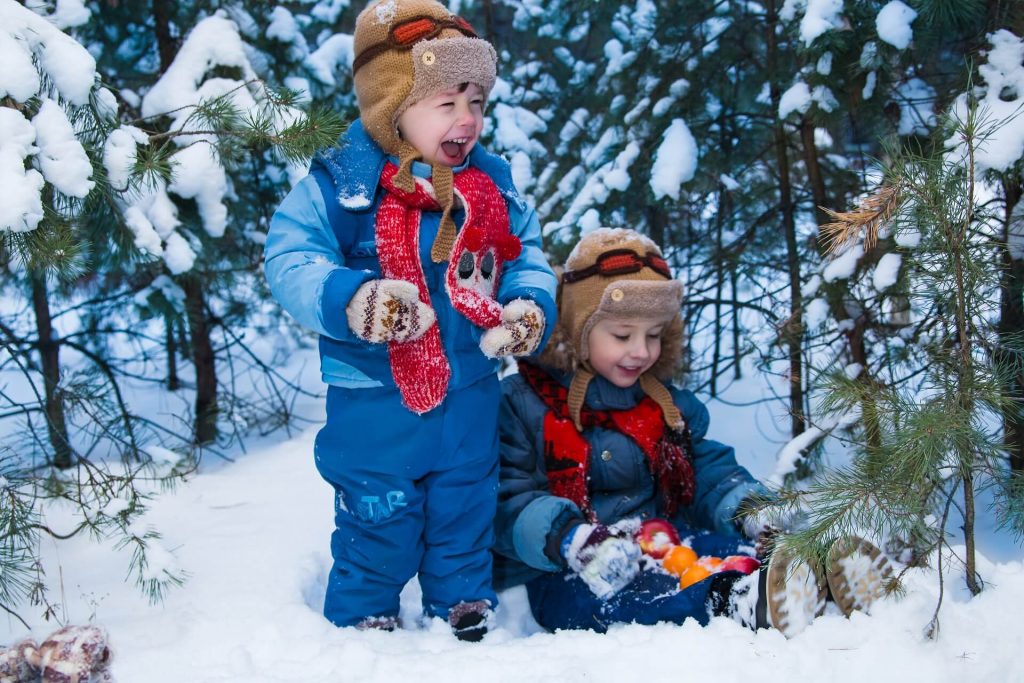
Prostock-studio/Shutterstock.com
Basic winter safety rules:
- walk with the child – or send them on a walk on their own if they are old enough – but only during daylight hours;
- tell your son or daughter that they can only walk in open and well-lit streets as playing in deserted areas can be dangerous;
- explain to your child that snow is dirty, and if they eat it, they can get sick;
- whilst celebrating Christmas or New Year and other festivities, do not use fireworks and explain to your children that such devices are a very common cause of fires;
- if the child is going on walks on their own, purchase a smart device for them, such as a phone or a kid’s GPS-watch.
In order not to lose your child out of sight and not to worry about them when they are away, download the Findmykids app on your phone or purchase a smartwatch with an already built-in license! With this kit, you can track the child’s location on a map, see their daily route, and listen to what is happening around them.
Rules of behavior on the street and on the road
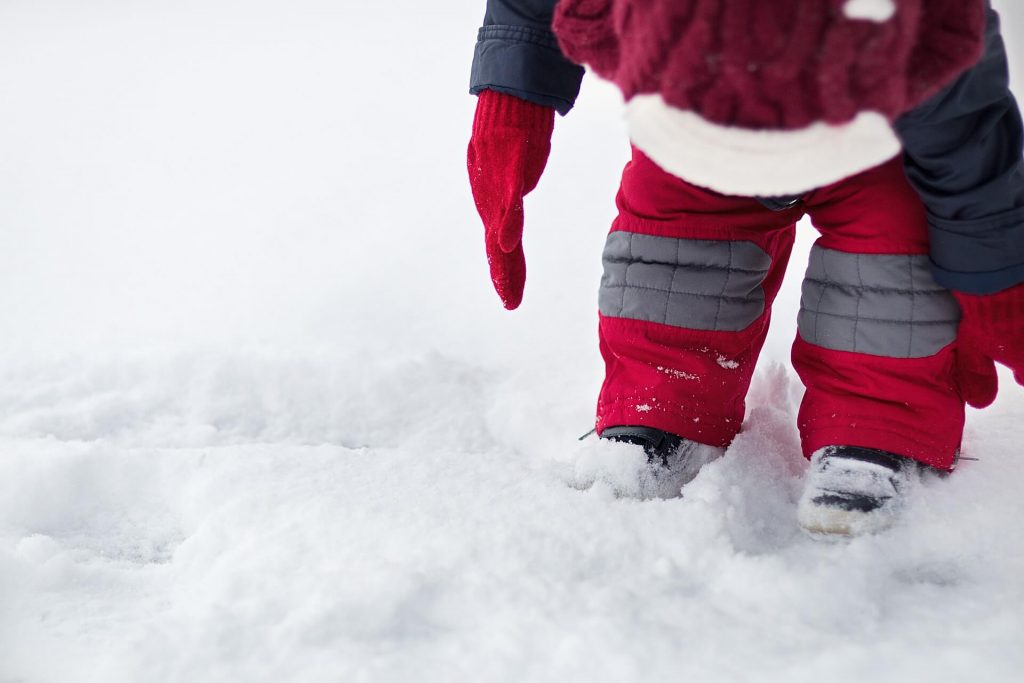
Prostock-studio/Shutterstock.com
Attentive behavior on the street and on the road is always appropriate. However, this is particularly important in winter. During the cold season, it gets dark early: at dusk, visibility becomes worse, and the outlines of objects (for example, cars) can become completely distorted.
Of course, potential dangers cannot serve as a reason to lock your child at home until summer. Explain to your child that the following needs to be done:
- returning home immediately if the weather suddenly turns much colder or if the wind becomes noticeably stronger;
- staying away from rooftops, which may have icicles or snow blocks falling from them;
- crossing the road only on a pedestrian crossing, having previously made sure not only that there are no cars, but also that there is a good view of the road. Due to snowdrifts, it is easy to miss an approaching car;
- not walking along the edge of the sidewalk and not stopping at the road itself;
- selecting places that are not too crowded, for very active activities, for example, playing snowballs, in order not to accidentally injure small children or the elderly;
- always keeping in touch with parents, and if an emergency arises, immediately calling mom or dad.
Being by the water during winter
Prostock-studio/Shutterstock.com
During the cold season, spaces with water represent an increased danger for both children and their parents. If you still need to go to the water, follow the proven safety rules:
- going out on the ice alone is dangerous, but walking in a frozen body of water in a large group is also risky. The safest way to move on the ice of the reservoir is at a distance of 5-6 meters away from each other;
- test the ice for thickness and reliability with a stick, not with your feet;
- it is dangerous to walk on ice covered with snow – it is easy not to notice cracks and holes;
- avoid walking on ice, if it starts raining and if the wind and/or blizzard intensify;
- if ice starts cracking under the feet, return to the shore immediately, preferably in the horizontal lying down position, following the same path that has already been used.
Slippery ice and icicles
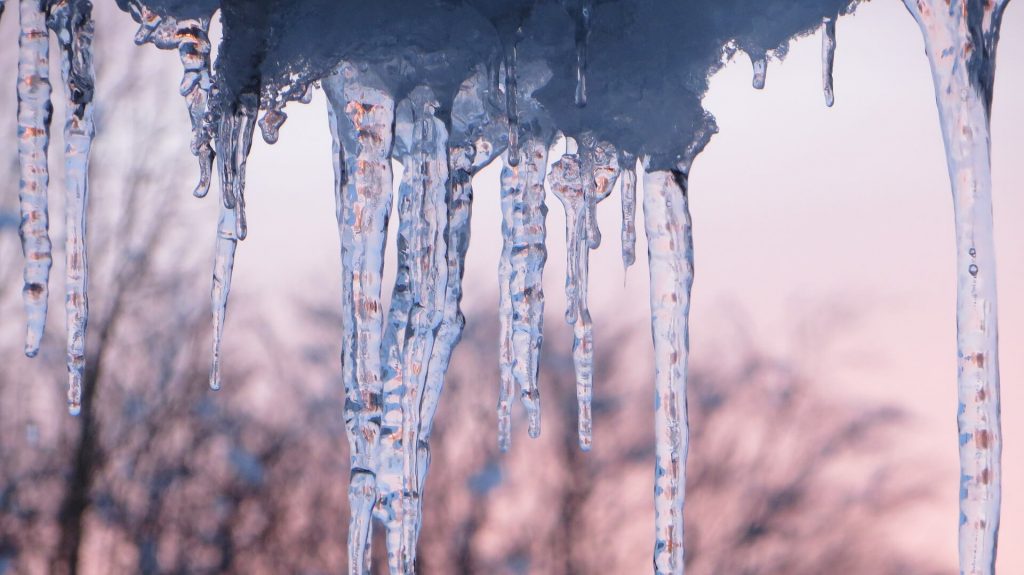
Prostock-studio/Shutterstock.com
Discuss the possible dangers of ice with your child: your son or daughter should remember that they need to be especially careful on the road – the car will not be able to stop abruptly on a slippery road.
Tell the children to avoid frozen puddles, stairs and slopes – there is a higher chance of slipping on them than on a flat surface. Show your son or daughter the correct technique for walking on ice: in small steps and with spreading the bodyweight on the entire sole of the foot.
Every time before going on a walk, remind your child about the dangers of playing under the roofs of multi-storey buildings, where there is a high probability of icicles falling. Explain to small children who really want to taste everything, that by licking an icicle, the child not only risks catching a cold, but also swallows chemical waste and bird droppings contained in the frozen water.
Wintertime walks: what needs to be known

Prostock-studio/Shutterstock.com
A safe wintertime walk begins at the doorstep of the house. Get ready for this walk with the child in advance in the following ways:
- feed your child a nutritious meal, as much more energy is used up in the cold than in the warm weather;
- make sure that the child is fully dressed (that they buttoned the locks, put on a hat and gloves) before walking out;
- explain that other children should not be pushed too hard when playing, especially those who are younger;
- warn your child about the dangers of jumping into a snowdrift, as it may contain lots of dangerous things such as sharp stones, fragments of items and debris.
The length of a wintertime walk with the child

Prostock-studio/Shutterstock.com
Тhe table below tells parents about the duration of the wintertime walk with the temperature of air not below -15°С:
| The age of the child | The duration of the walk |
| Below 1 year old | 1-1,5 hours |
| 1-2 years old | 1-2 hours |
| 2-4 years old | 1,5-3 hours |
| Over 4 years old | 2-4 hours |
It would be reasonable to shorten the walking time if the outdoor temperature drops below -15°C. It is better to divide the total duration of the walk with a child of the age of under 4 years old into 2-3 separate outings, for instance, in the morning, in the afternoon and in the evening. It is better for children with a cold to refrain from walking in the midst of an illness and shorten the time spent outside when the child is recovering from it.
Up to what temperature a walk outside could take place?
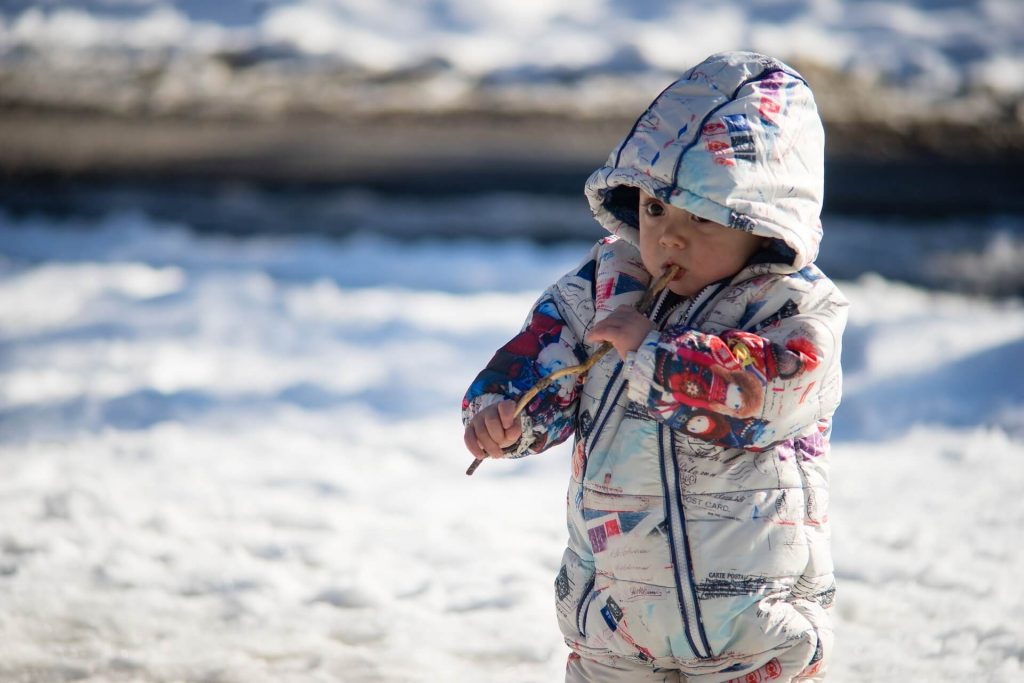
Prostock-studio/Shutterstock.com
Pediatricians recommend walking with babies younger than 6 months at an air temperature of at least -6°C. With older children, 6-12 months old, you can go outside if the temperature is -10°C. With an older child, 1 hour walks at an air temperature of at least -15°C are allowed if the baby is already good at walking and is active outside. Highly active children of the age over 5 years old can also walk outside at a temperature as low as -20°C, if it is sunny and not windy outside.
The right clothing
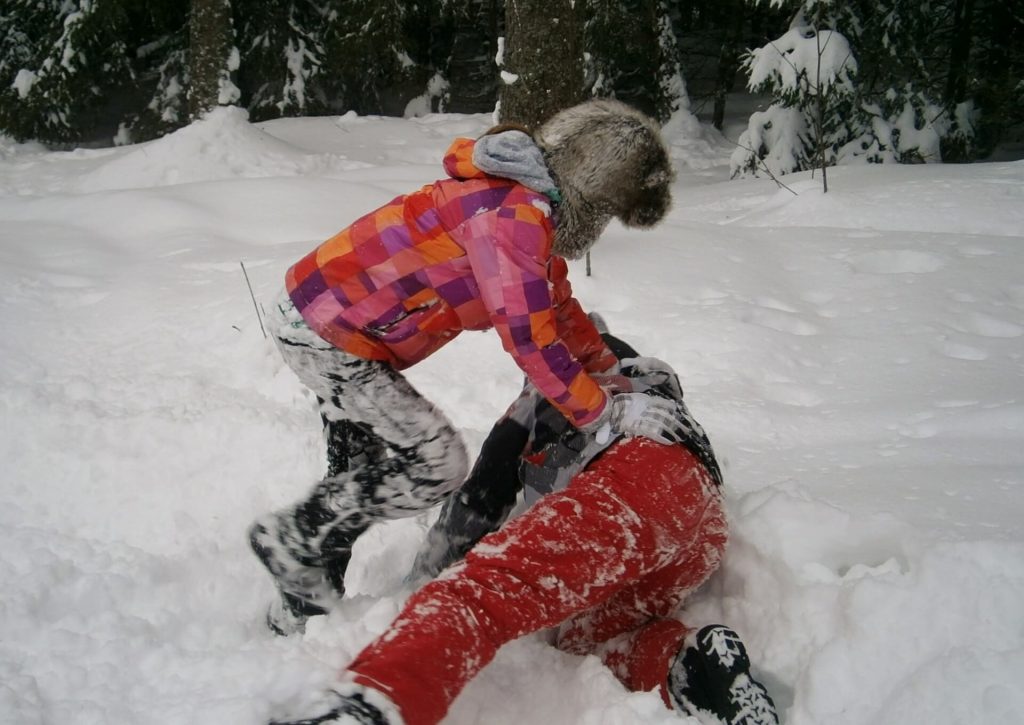
Prostock-studio/Shutterstock.com
What needs to be known when getting children dressed for a wintertime walk:
- Don’t dress your child too warmly “just in case” – overheating is no better than hypothermia. Put as many layers of clothing on your son or daughter, as you would put on yourself, or one extra layer if you are going for a walk with a baby of the age under one-year-old.
- Opt for loose clothing that does not hinder movement.
- Make sure that the first layer of clothing on your child is synthetic or woolen. Cotton gets wet quickly and dries very slowly on a hot sweaty body.
- Have your child wear footwear that fits their size – in tight shoes, there is a high risk of getting frostbite on the feet.
- In winter, it is recommended to wear mittens as they retain heat better than gloves. If the child is small, attach an elastic band to the mittens so that the child does not accidentally lose them.
Tip for parents. Try to maintain the room temperature of 18-20°C in your home. This way, you can avoid a sharp temperature drop when walking out of the house, allowing the child to catch colds less often. Humidify the air in the apartment with a humidifier device or simply with a damp towel on the heating unit. An excessively dry air dries the respiratory tracts out and children get sick much easier.
Your child is walking on their own? Download the Findmykids app in order to make sure that everything is good with them– define their location precisely, listen to the sounds around them and get in touch with them quickly in the event of need.
Wintertime fun and child safety
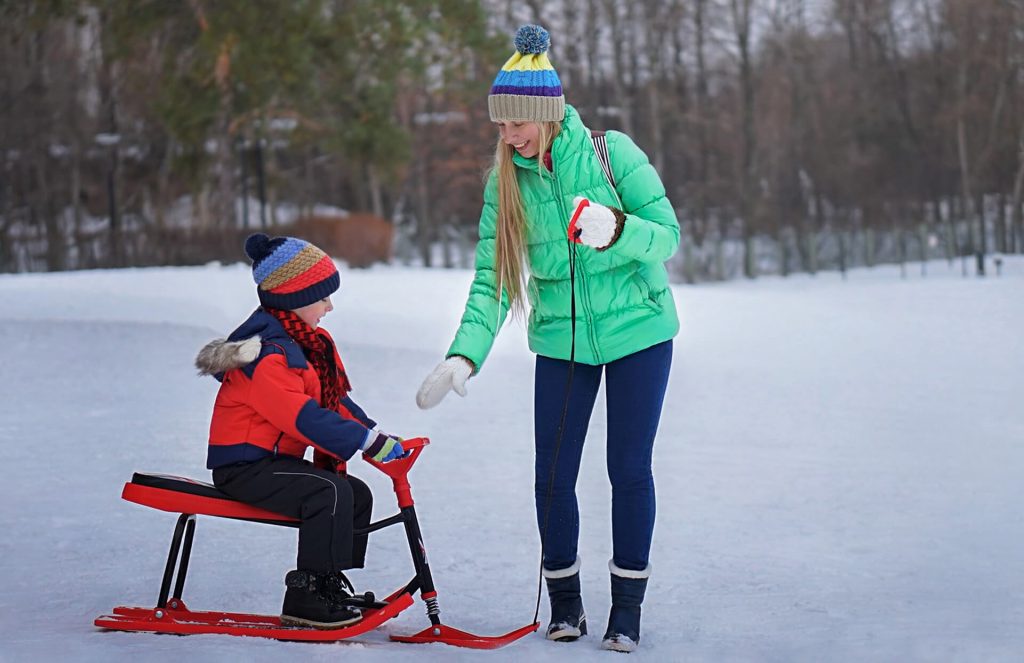
Prostock-studio/Shutterstock.com
Every wintertime activity has got its own particularities. However, there some general safety rules during winter playtime that would be highly beneficial for the child:
- the hat and the scarf must not be taken off, even if a child is feeling warm or if other children find these clothing items “unfashionable”;
- tell your child that if they feel that they are getting cold or that their feet are wet, you should immediately return home and have the child change into dry clothes;
- if for some reason a child whose cold, cannot immediately enter a warm room, don’t let them stop moving in order to stimulate their blood circulation;
- all games should take place far from the road.
Skiing and snow scooters

Prostock-studio/Shutterstock.com
Ski and snow scooters are one of the safest wintertime fun activities. Under adult control, children may start learning to ski from the age of 4-5 years old.
Safety rules for young skiers and their parents:
- for skiing, do not choose a very steep slide, preferably in a park or in a place where there is no car traffic;
- have your child wear a protective helmet if you plan to ride on shared slides, where there is a risk of colliding with other skiers;
- dress your child in a bright suit – this way they will be visible on the slope;
- if the child has never skied before, first just teach them to walk on a ski;
- ski poles are not required for a beginner skier, without the extra support, they will quickly learn to maintain balance.
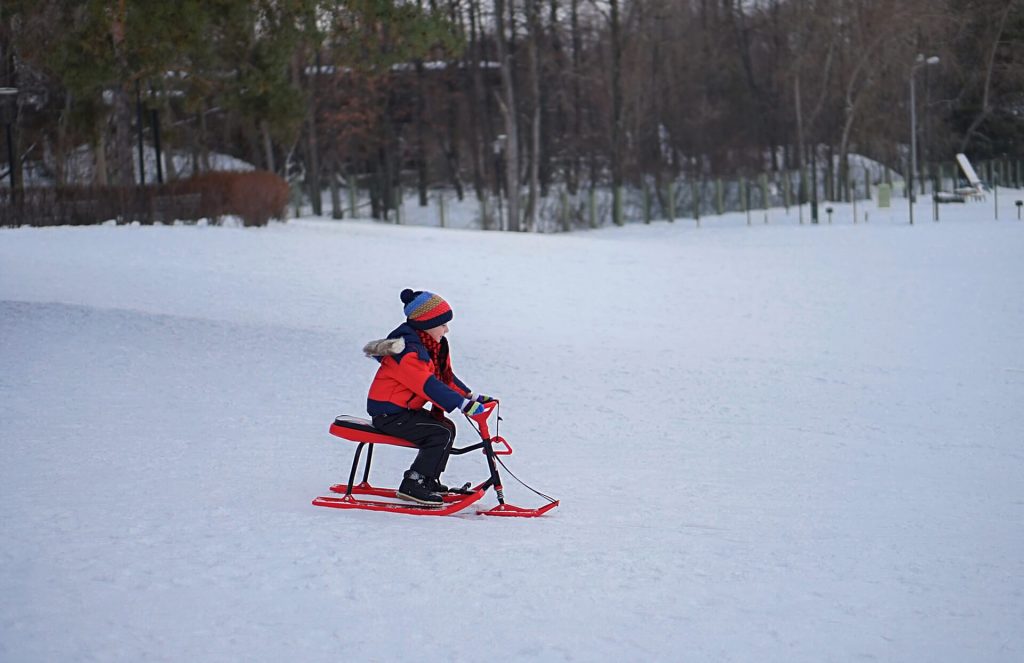
Prostock-studio/Shutterstock.com
Snow scooters are like sleds, where skis are used instead of runners. They are easy to drive, however, they require some specific security measures to be taken:
- choose a smooth slide without large obstacles (stones, trees) on the descent for skiing with your child;
- show your child how to operate a snow scooter by using the steering wheel and brakes;
- help the child to bring the snow scooter to the top of the slide if it is difficult for the child to cope on their own.
Ice skating: behavior on the ice
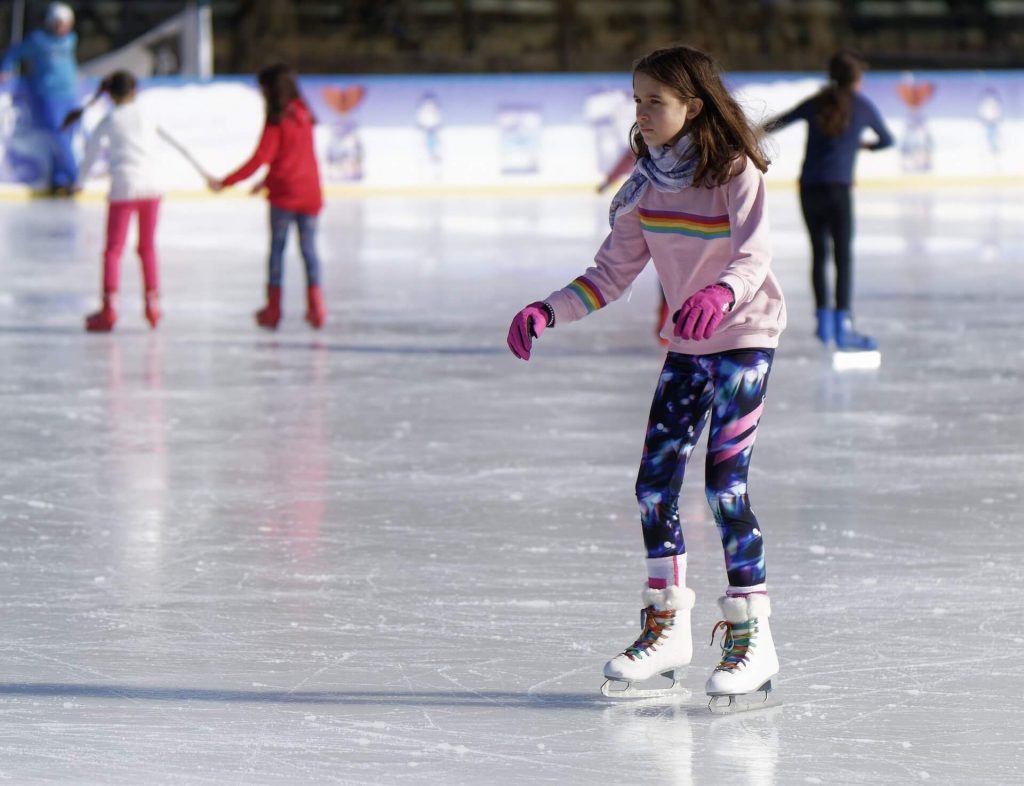
Prostock-studio/Shutterstock.com
The main condition for safe skating is the choice of a specially equipped skating area. For the first time, you can bring the child on the ice at the age of 3 years old. Other rules of conduct on ice include the following:
- have your child wear a protective helmet, knee pads and elbow pads at all times;
- choose a time when there are few other people on the ice rink to go to the skating rink with a beginner skater. An absence of lots of people on it will help to avoid injuries;
- try to remain nearby at all times to help the child if they need it;
- for the first time on the ice rink, walk from one edge of the rink to the other with a side step, with your child;
- teach your child the correct technique of falling: they need to regroup themselves and fall on the side.
Riding the slide: safety rules

Prostock-studio/Shutterstock.com
When choosing a slide for a child to ride, pay attention to the safety of this ride. There should be no roads or water near the hill. If you are going to ride with a small child, the accumulation of active teenagers on the slide may become a potential danger to them.
What parents and children need to know — safety measures for riding the sleigh in winter:
- remind your son or daughter that politeness is good everywhere, and that includes the hill as well: have your child give way to younger children and respect their turn to ride;
- watch the child ride, especially if they are still small and there are many other children on the hill;
- only allow a child under 5 years old to ride on easy slides;
- have your child wear non-slip footwear before going up the hill;
- allow the child to ride only on special riding equipment, such as snow saucers and snow-scooters, but not on their feet or their bottoms.
Sleighs, snow saucers and tubes: what we need to know
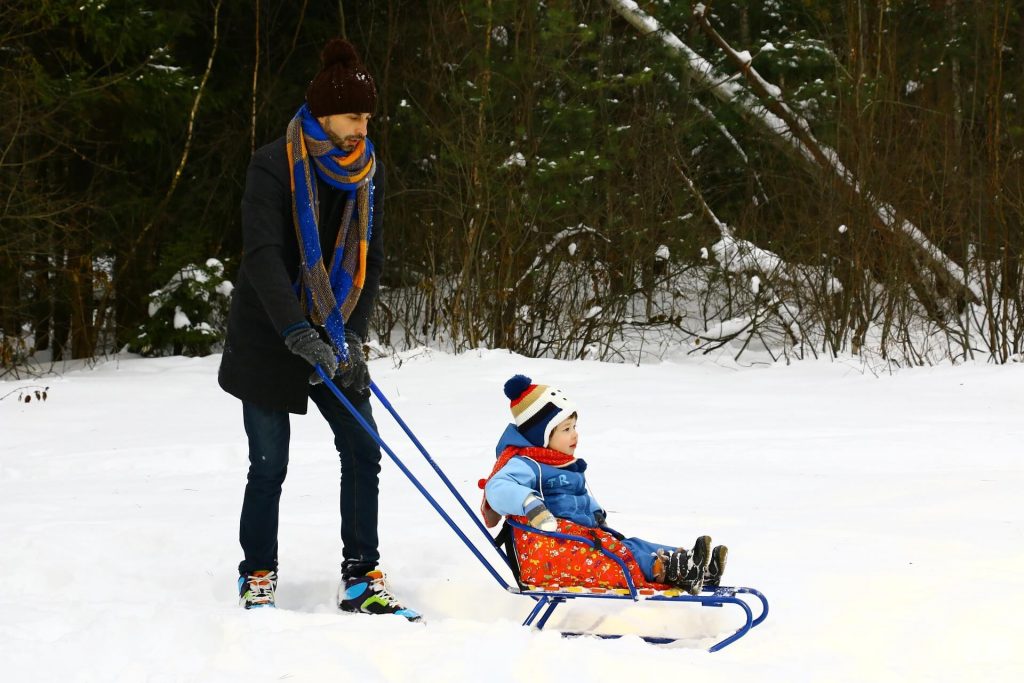
Prostock-studio/Shutterstock.com
Sleds, ice skids and tubes are equally well suited for downhill riding, however, they differ in some characteristics, including their degree of safety. The safest device for descending is a sled, the most difficult to handle is a tube. Snow saucers are good for their lightness and low price, but sleds are a little better from a safety standpoint – it is more difficult to control a snow saucer than a sled.
How to make the activity of riding a snow saucer safe:
- for flat surface ice slides, simple oval ice slopes with one handle are suitable, whereas, for snow slopes, snow saucers with two handles and recesses for the legs are the best option;
- do not use snow saucers in the form of a plate, as on slippery surfaces, such devices become uncontrollable;
- for using the sleigh, only choose smooth slides, without bumps and jumps, in order to avoid back injury.
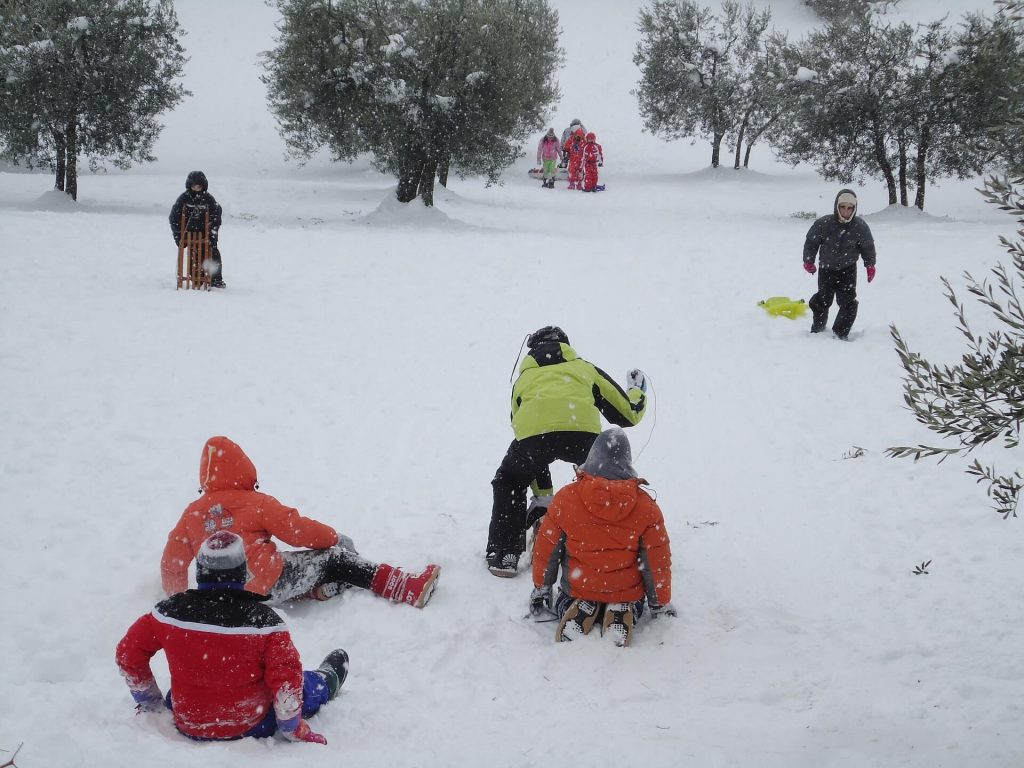
Prostock-studio/Shutterstock.com
Safety rules for riding the sled:
- if the child is younger than 5 years old — choose a slide without any abrupt descend;
- remind your child to hold on tightly to the sled with their hands as they descend;
- tell your child not to go down the sled while standing, lying down or sitting against the direction of the movement.
Safety measures when riding snow saucers (tubing):
- rides that are not too steep are appropriate for tubing – as such devices are light, and the child may find it hard to control them;
- explain to your child that collision with other children on the snow saucer can lead to injury, therefore, let them ride on the tube when the risk of collision is minimal;
- stay close to the slide if you come to ride a snow saucer with a small child.
Frostbites and injuries: first aid for the child
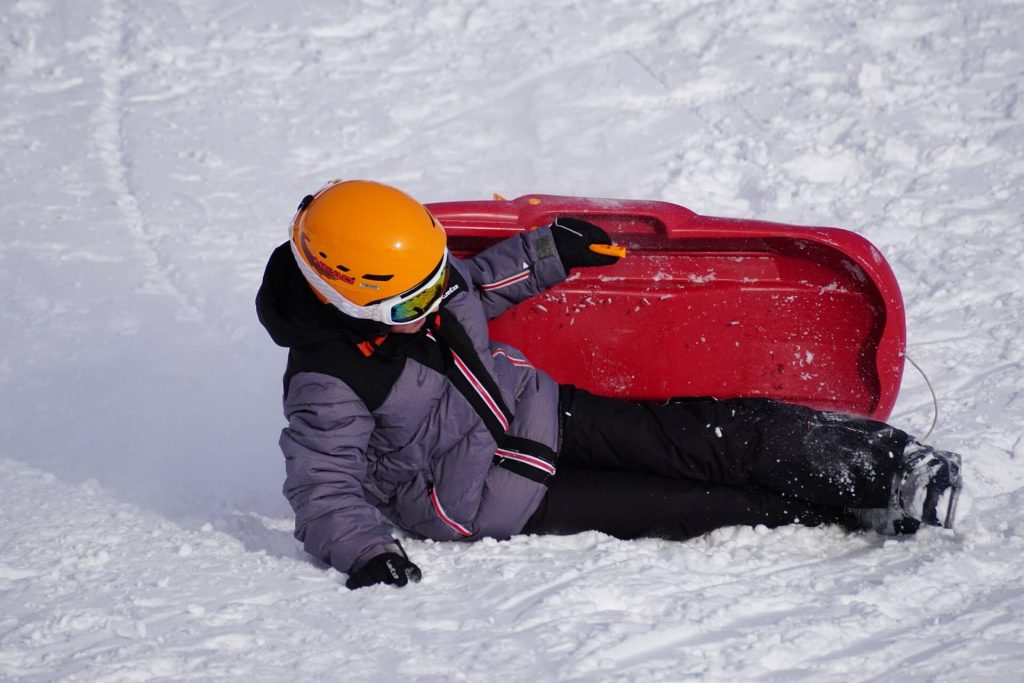
Prostock-studio/Shutterstock.com
Parents often think that only careless adults can allow their children to get frostbite and injuries. This is far from the truth: doctors note that every winter, children of caring parents who were not attentive enough during walks, are admitted to the hospital with various injuries and symptoms of frostbite. Learn to provide first aid for frostbite and injuries, in order to be able to do so without panic, should this become necessary in an emergency situation.
First aid in the event of an injury
If the child fell and injured themselves, firstly, take them to a quiet place and ask where and how it hurts. With a good state of health and a normal movement of the limbs, it is possible that the child will only get a bruise, which is treated very simply. In any case, observe the child’s condition: if their state of health has worsened, consult a doctor.
Call an ambulance without thinking twice if the child manifests the following symptoms:
- the child has hurt their head;
- you suspect that the child may have a dislocation, sprain, or fracture;
- the child complains of abdominal pain.
Do not undress the child and do not put on a splint, so as not to get frostbite in addition to the injury. The exception to this advice would be heavy bleeding, which, while waiting for the doctor, must be stopped with a tight bandage.
The signs of frostbite and first aid
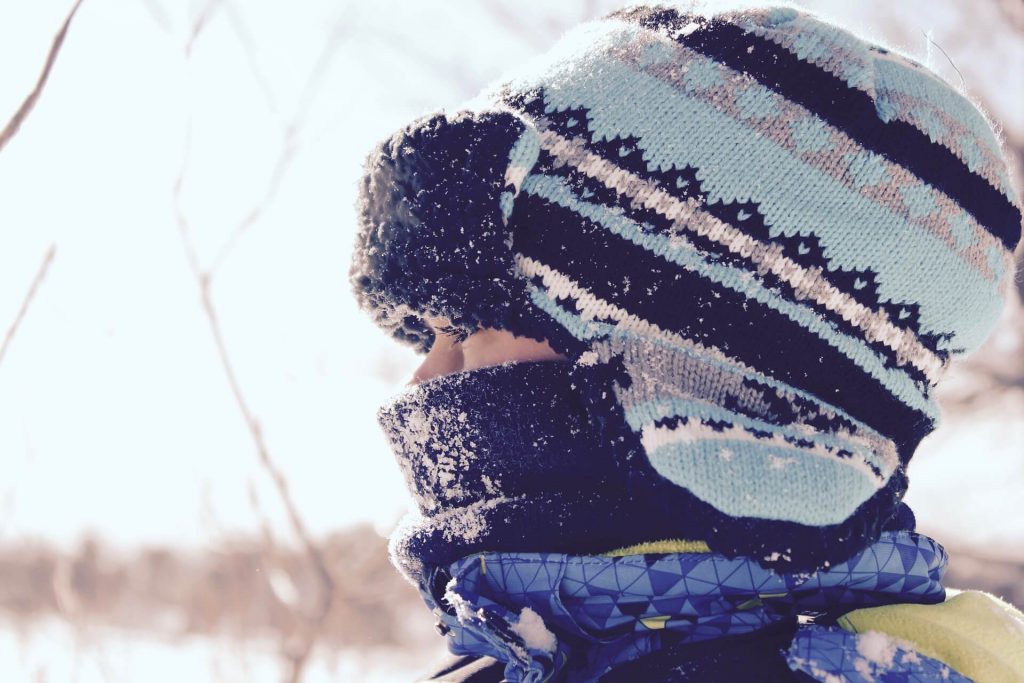
Prostock-studio/Shutterstock.com
Contrary to popular belief, frostbite could be gotten not only in the cold, but also at an air temperature of about zero degrees, especially in the event that the wind outside is strong.
The signs of frostbite:
- the affected area of the body loses sensitivity;
- the skin turns red, there is a tingling sensation;
- if no action is taken in time, blisters appear.
If you notice signs of frostbite in a child, bring them indoors immediately. Place the affected part of the body in warm water, and then rub the skin to restore sensitivity.
What to do if the child’s tongue got stuck together with a cold surface?
If the child, despite the warnings, still manages to lick a cold metal surface, here are the urgent measures to be taken:
- calm the child down so that they do not twitch and hurt their tongue;
- pour warm water or other warm liquid on the child’s tongue;
- if you don’t have any liquids with you, breathe on the child’s tongue, placing the palms of your hands to your mouth.
Winter safety is very important. But, of course, children surely want to play around and to have fun. Try not to turn safety explanations into boring material: be subtle, involve cartoons, fairy tales, and themed games when telling the child about safety precautions. And most importantly, always lead by example!
Проверьте электронный ящик


















